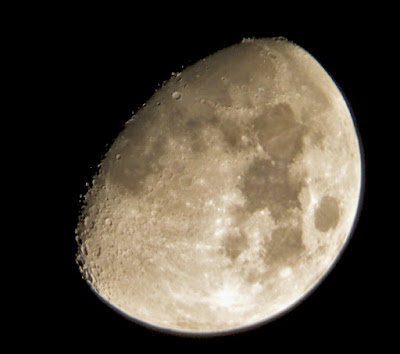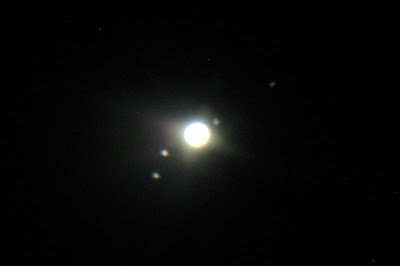This summer, I was not as diligent about getting out to view the night sky with my telescope as I was last year. I realized that something was missing, that there was a reason the sky didn't have the same allure as before: Jupiter was not out when I could view it this summer. Last year, I spent countless nights just staring at this beautiful planet and looking for its moons. As fall arrived, Jupiter again appeared in my evening sky when I could easily spot it at a reasonable hour. That was motivation enough. I got out my telescope a couple times recently and was able to once again enjoy the splendor of this gas giant. What’s more – I even found a better way to take a photograph through my telescope! While not as nice of an image as you’d get from a “real” telescope or a “real” camera that could actually connect to it, I don’t think this is bad for a small point and shoot aimed carefully through a tiny eyepiece! Here’s what I was able to get on the first night:
You can see four of Jupiter’s moons in this picture. These are called its “Galilean” moons, since Galileo Galilei was the one to discover them. They are the four largest of Jupiter’s many (at least 64) moons and they are often visible right along with the planet through a small telescope. It’s fun to see them all in a line.
Once I realized that I was getting better at using my camera through my telescope, I decided to turn my eye piece to the moon. We had a waxing gibbous moon that was brilliant and splendid! I learned a couple more tricks with my camera to capture some decent pictures.
 |
| Waxing Gibbous Moon - 10/4/11 |
Several nights later I wanted to try some different camera settings on Jupiter, and here’s what I was able to capture.
Something in me just stands in awe when I realize I am staring at a whole planet, so far away, yet even some of its moons are visible. It gives you a little bit of an idea of the sheer magnitude of both planet and moons. You can't tell in the pictures, but through the telescope, you can actually make out some of the atmospheric bands around Jupiter.
For good measure, I captured some additional moon shots over a couple nights:
 |
| Waxing Gibbous Moon - 10/6/11 |
 |
| Near Full Moon |
ABOUTME
Hi there! My name is Dana and I live in West Michigan with my husband, Tom and our dog Copernicus. I created this space as a place to share the things I learn along this journey I call life. I work in marketing and I'm a sort of Jane of All Trades, interested in all things nature, gardening, cooking, exploring and learning new things. This blog is a conglomeration of my interests, hobbies, life and life lessons. Thanks for stopping by!






